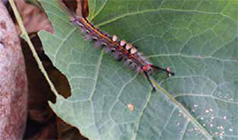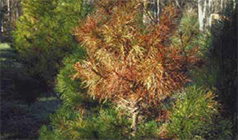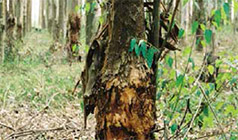The following are some key high priority exotic pest threats for plantation forests as identified through the development of the Plantation Forest Biosecurity Plan. Any of these pests would have serious consequences should they enter and become established in Australia.
Information about other pests of plantation forests is available from the plantation forestry industry page on the Plant Health Australia website.
Implementing biosecurity measures to control endemic pests will go a long way towards preventing exotic pests from entering and becoming established on your property.
To improve biosecurity measures on your farm, include exotic pests when undertaking routine pest surveillance activities. Ensure that all surveillance activities, for both endemic and exotic pests, are recorded.
Lateral view of adult beetle. Pest and Diseases Image Library, Bugwood.org
Mountain pine beetle (Dendroctonus ponderosae )
Small, 4-7.5mm long, dark or light brown coloured beetle
Lodgeole and ponderosa pine are the main hosts affected
Infestations cause the foliage of infested trees to yellow then become red
Fact sheet
Pitch tubes on Ponderosa pine. Donald Owen, California Department of Forestry and Fire Protection, Bugwood.org
Red turpentine beetle (Dendroctonus valens )
Reddish-brown coloured, 7- 12 mm long beetle
Larvae feed under the bark of various softwoods including Radiata pine
Primarily attacks the bottom 3 m of weakened trees (e.g. after fire)
Infestations can cause tree death
Fact sheet
Larval galleries. Jan Liska, Forestry and Game Management Research Institute, Bugwood.org
European spruce bark beetle (Ips typographus )
Dark brown to black coloured, 4.2 to 5.5 mm long beetle with long yellow hairs on the head and body
Infestations cause needles to change colour and can kill infested trees
Spruce is the main host affected, but pine, fir and larch are also susceptible
Fact sheet
Adult female. Note black stripe on abdomen. Peter Lillywhite, Museum Victoria, PaDIL
Giant wood wasp (Urocerus gigas )
Large, 10-40mm long, yellow and black coloured wasp
Usually affects stressed softwoods including pine, fir, cedar and spruce
Larvae bore into the tree creating feeding galleries and cause significant damage
Fact sheet
Larval form of White spotted tussock moth. Harum Koh, Flicker
White spotted tussock moth (Orgyia thyellina )
Medium sized moth with a wingspan of 25-40 mm
Larvae are up to 30 mm long and have distinctive white tufts of hair and orange stripes along each side of the body
Larvae feed on a range of hosts including softwoods and hardwoods
Larvae can cause significant defoliation
Fact sheet
Adult female (L) and male (R). Hannes Lemme, Bugwood.org
Nun moth (Lymantria monacha )
Medium sized moth with a wingspan of 35-55 mm
Larvae are up to 35 mm long with a grey-yellow body and tufts of hair along the body
Larvae feed on the foliage of a range of trees including hardwoods and softwoods
High populations can cause significant defoliation
Fact sheet
Male (L) and female (R) adult Gypsy moths. USDA APHIS PPQ, Bugwood.org
Gypsy moth
Lymantra dispar asiatica and L. dispar dispar Very wide host range, with over 650 known hosts
Egg masses laid on solid surfaces and covered in light tan fuzz
Mature caterpillars are large (50-65 mm long) and hairy with two rows of spots (red and blue) along their back
Moths have greyish-brown wings (30-40 mm wingspan) in males or white with grey markings (40-70 mm) in females
Causes heavy defoliation and larvae may produce webbing
Can spread large distances naturally or with infested plant material
Fact sheet
Symptoms of Pine pitch canker. Edward L Barnard, Florida Department of Agriculture and Consumer Services, Bugwood.org
Pine pitch canker (Fusarium circinatum )
Fungal pathogen that affects pines and Douglas fir
Fungus causes needles to discolour and turn red
Infected branches ‘bleed’ honey coloured resin
Infections reduce timber production and cause tree mortality
Fact sheet
Drops of resin at base of infected needles. Rodrigo Ahumada, Bioforest SA, Chile
Daño foliar del pino (Phytophthora pinifolia )
Fungal pathogen that affects the needles of Radiata pine
Infection causes needles to die, causing the crown to become grey red in colour
Severe infections can kill young (1-2 year old) trees
Fact sheet
The needles of red needle cast are easily shed from the tree. Scion, New Zealand Forest Research Institute Ltd
Red needle cast (Phytophthora pluvialis )
Fungal pathogen that affects the needles of Radiata pine
Infected needles develop pale olive or khaki coloured regions with resinous bands
Infections can cause significant defoliation
Fact sheet
Immature gall (less than 2 years old). Cesar Calderon, USDA APHIS PPQ, Bugwood.org
Western gall rust (Endocronartium harknessii )
Fungal pathogen that affects two and three needled pines, including Radiata pine
The fungus causes the formation of woody galls on the stems and branches
Heavy infections result in suppressed growth and premature death
Fact sheet
Pinewood nematode infected Black pine (P. nigra). USDA Forest Service – North Central Research Station Archive, Bugwood.org
Pinewood nematode (Bursaphelenchus xylophilus )
Nematode species that multiply in the resin canals of softwoods (including pine)
Infections cause wilting and rapid (often only 30-40 days after infection) tree death
Vectored by exotic Pine sawyer beetles (Monochamus spp.)
Fact sheet
Feeding Japanese pine sawyer beetle, a vector of the Pinewood nematode. Jijing Song and Juan Shi, Beijing Forestry University, Bugwood.org
Pine sawyer beetles (Monochamus spp. )
Large (up to 30 mm long), brown-grey coloured beetles with long antennae
Adult beetles feed on the young shoots of conifers
Larvae develop in weakened trees and can be detected by the presence of round exit holes
These beetles are most damaging due to their ability to act as vectors of the Pinewood nematode (Bursaphelenchus xylophilus )
Fact sheet
Swelling and cracking at the base of Eucalyptus spp. G Pegg, H&FS DAFF Queensland
Chrysoporthe canker (Chrysoporthe austroafricana )
Fungal pathogen of eucalypts
Infection on young trees causes wilt and dieback
Infections on older trees cause swelling, cracking and splitting of bark at the base of the trees. Cankers also develop on the trunk
Fact sheet
Twig dieback on Tan oak. Joseph O’Brien, USDA Forest Service, United States
Sudden oak death (Phytophthora ramorum )
Infects over 130 tree and shrub species
Symptoms in shrubs: blackened shoots, diffuse dark brown spots or blotches with fuzzy margins, starting at the leaf tip
Symptoms in trees: stem canker with red to black thick sap oozing on the bark surface.Stem necrosis leads to the death of whole crown
Spread with infected plant material, or water, growing media and compost that has been in contact with infected plants
Fact sheet
Lesions on immature stems of Flooded gum (E. grandis). G Pegg H&FS, DAFF Queensland
Teratosphaeria stem canker
Teratosphaeria gauchensis and Teratosphaeria zuluensis Fungal pathogen of eucalypts
Infection causes the formation of small necrotic spots on the bark
Necrotic spots develop into small cankers
Timber of infected trees is brittle and unsuitable for construction or sawn timber
Fact sheet















